#Japan Aerospace Space Agency (JAXA)
Explore tagged Tumblr posts
Text


Japan Aerospace Exploration Agency astronaut Soichi Noguchi during EVA STS-114-1, taken by NASA astronaut and fellow STS-114 crew mate Stephen Robinson. This 6 hour, 50 minute spacewalk demonstrated Shuttle thermal protection repair techniques, in addition to installing a stowage platform (ESP-2, attached to the Quest airlock) and rerouting power to ISS Control Moment Gyroscope 2. They also brought two materials exposure experiments into the ISS. July 30, 2005.
NASA 1, 2
#Space Shuttle#STS-114#International Space Station#Japan Aerospace Exploration Agency#JAXA#Soichi Noguchi#NASA#spaceflight#space
22 notes
·
View notes
Video
Gateway Full Configuration - Hero Image by NASA Johnson Via Flickr: The Gateway space station will be humanity's first space station around the Moon as a vital component of the Artemis missions to return humans to the lunar surface for scientific discovery and chart the path for the first human missions to Mars. Astronauts on Gateway will be the first humans to call deep space home during missions where they will use Gateway to conduct science and prepare for lunar surface missions. Photo Credit: NASA Secondary Creator Credit: Alberto Bertolin, Bradley Reynolds
#European Space Agency#Johnson Space Center#Kennedy Space Center#Moon#NASA#space#USA#station#Science#Canadian Space Agency (CSA)#Japan Aerospace Exploration Agency (JAXA)#flickr
45 notes
·
View notes
Text
Japan will make moon-exploration history in the middle of next month, if all goes to plan. The Japan Aerospace Exploration Agency (JAXA) announced today (Dec. 5) that it's targeting Jan. 19 for the lunar landing of its robotic SLIM ("Smart Lander for Investigating Moon") spacecraft. The newly revealed plan calls for SLIM to begin its descent toward the moon on Jan. 19 around 10 a.m. EST (1500 GMT; 12 a.m. on Jan. 20 Japanese Standard Time). Touchdown — which would mark the first-ever soft lunar landing for a Japanese spacecraft — is scheduled to occur about 20 minutes later. The 8.8-foot-long (2.7 meters) SLIM probe launched atop a Japanese H-2A rocket along with an X-ray space telescope called XRISM on Sept. 6. XRISM deployed into low Earth orbit, but SLIM began making its circuitous, fuel-efficient way to the moon. If all goes smoothly, SLIM will enter lunar orbit on Christmas Day, then spend nearly a month prepping for its technology-demonstrating touchdown attempt. Success would make Japan just the fifth nation to put a probe down on the moon, after the Soviet Union, the United States, China and India. This landing could also open doors for even more ambitious exploration feats down the road.
Conitnue Reading.
62 notes
·
View notes
Text


TOKYO, Sept 7 (Reuters) - Japan launched its lunar exploration spacecraft on Thursday aboard a homegrown H-IIA rocket, hoping to become the world's fifth country to land on the moon early next year.
Japan Aerospace Exploration Agency (JAXA) said the rocket took off from Tanegashima Space Center in southern Japan as planned and successfully released the Smart Lander for Investigating Moon (SLIM).
Unfavourable weather led to three postponements in a week last month.
Dubbed the "moon sniper," Japan aims to land SLIM within 100 metres of its target site on the lunar surface.
The $100-million mission is expected to start the landing by February after a long, fuel-efficient approach trajectory.
"The big objective of SLIM is to prove the high-accuracy landing ... to achieve 'landing where we want' on the lunar surface, rather than 'landing where we can'," JAXA President Hiroshi Yamakawa told a news conference.

The launch comes two weeks after India became the fourth nation to successfully land a spacecraft on the moon with its Chandrayaan-3 mission to the unexplored lunar south pole.
Around the same time, Russia's Luna-25 lander crashed while approaching the moon.
Two earlier lunar landing attempts by Japan failed in the last year.
JAXA lost contact with the OMOTENASHI lander and scrubbed an attempted landing in November.
The Hakuto-R Mission 1 lander, made by Japanese startup ispace (9348.T), crashed in April as it attempted to descend to the lunar surface.
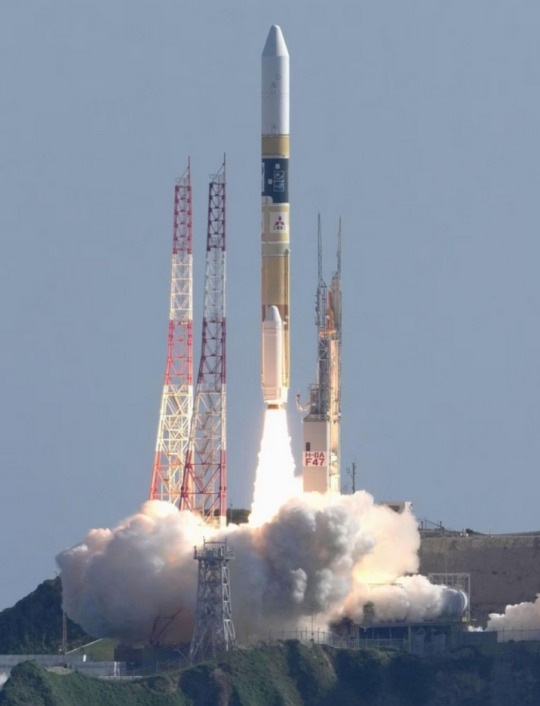
SLIM is set to touch down on the near side of the moon close to Mare Nectaris, a lunar sea that, viewed from Earth, appears as a dark spot.
Its primary goal is to test advanced optical and image processing technology.
After landing, the craft aims to analyse the composition of olivine rocks near the sites in search of clues about the origin of the moon. No lunar rover is loaded on SLIM.
Thursday's H-IIA rocket also carried the X-Ray Imaging and Spectroscopy Mission (XRISM) satellite, a joint project of JAXA, NASA and the European Space Agency.
The satellite aims to observe plasma winds flowing through the universe that scientists see as key to helping understand the evolution of stars and galaxies.

Mitsubishi Heavy Industries (7011.T) manufactured the rocket and operated the launch, which marked the 47th H-IIA rocket Japan has launched since 2001, bringing the vehicle's success rate close to 98%.
JAXA had suspended the launch of H-IIA carrying SLIM for several months while it investigated the failure of its new medium-lift H3 rocket during its debut in March.
Japan's space missions have faced other recent setbacks, with the launch failure of the Epsilon small rocket in October 2022, followed by an engine explosion during a test in July.
The country aims to send an astronaut to the moon's surface in the latter half of the 2020s as part of NASA's Artemis programme.
https://www.reuters.com/technology/space/japan-launches-rocket-carrying-moon-lander-slim-after-three-delays-2023-09-06/
youtube
Japan launches 'Moon Sniper' mission | AFP
7 September 2023
Japan's "Moon Sniper" mission blasted off Thursday as the country's space programme looks to bounce back from a string of recent mishaps, weeks after India's historic lunar triumph.
#H-IIA rocket#Japan#lunar exploration spacecraft#SLIM#moon sniper#Japan Aerospace Exploration Agency (JAXA)#Tanegashima Space Center#Smart Lander for Investigating Moon#Hiroshi Yamakawa#Hakuto-R Mission 1 lander#ispace#Mare Nectaris#X-Ray Imaging and Spectroscopy Mission (XRISM) satellite#JAXA#NASA#European Space Agency#Mitsubishi Heavy Industries#Artemis#space#space rocket#Youtube#Chandrayaan-3 mission#Luna-25 lander#India#Russia#moon#moon landing
25 notes
·
View notes
Text
A Tour of Cosmic Temperatures
We often think of space as “cold,” but its temperature can vary enormously depending on where you visit. If the difference between summer and winter on Earth feels extreme, imagine the range of temperatures between the coldest and hottest places in the universe — it’s trillions of degrees! So let’s take a tour of cosmic temperatures … from the coldest spots to the hottest temperatures yet achieved.
First, a little vocabulary: Astronomers use the Kelvin temperature scale, which is represented by the symbol K. Going up by 1 K is the same as going up 1°C, but the scale begins at 0 K, or -273°C, which is also called absolute zero. This is the temperature where the atoms in stuff stop moving. We’ll measure our temperatures in this tour in kelvins, but also convert them to make them more familiar!
We’ll start on the chilly end of the scale with our CAL (Cold Atom Lab) on the International Space Station, which can chill atoms to within one ten billionth of a degree above 0 K, just a fraction above absolute zero.

Credit: NASA's Goddard Space Flight Center/Scott Wiessinger
Just slightly warmer is the Resolve sensor inside XRISM, pronounced “crism,” short for the X-ray Imaging and Spectroscopy Mission. This is an international collaboration led by JAXA (Japan Aerospace Exploration Agency) with NASA and ESA (European Space Agency). Resolve operates at one twentieth of a degree above 0 K. Why? To measure the heat from individual X-rays striking its 36 pixels!

Credit: NASA's Goddard Space Flight Center/Scott Wiessinger
Resolve and CAL are both colder than the Boomerang Nebula, the coldest known region in the cosmos at just 1 K! This cloud of dust and gas left over from a Sun-like star is about 5,000 light-years from Earth. Scientists are studying why it’s colder than the natural background temperature of deep space.
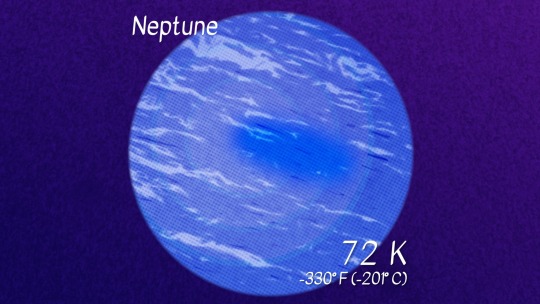
Credit: NASA's Goddard Space Flight Center/Scott Wiessinger
Let’s talk about some temperatures closer to home. Icy gas giant Neptune is the coldest major planet. It has an average temperature of 72 K at the height in its atmosphere where the pressure is equivalent to sea level on Earth. Explore how that compares to other objects in our solar system!

Credit: NASA's Goddard Space Flight Center/Scott Wiessinger
How about Earth? According to NOAA, Death Valley set the world’s surface air temperature record on July 10, 1913. This record of 330 K has yet to be broken — but recent heat waves have come close. (If you’re curious about the coldest temperature measured on Earth, that’d be 183.95 K (-128.6°F or -89.2°C) at Vostok Station, Antarctica, on July 21, 1983.)
We monitor Earth's global average temperature to understand how our planet is changing due to human activities. Last year, 2023, was the warmest year on our record, which stretches back to 1880.
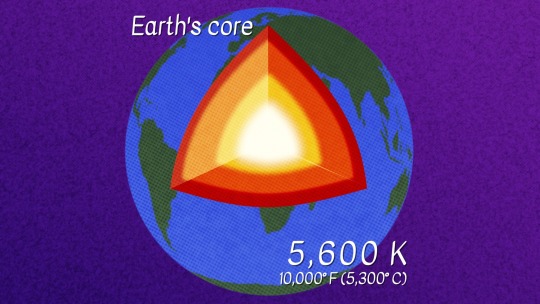
Credit: NASA's Goddard Space Flight Center/Scott Wiessinger
The inside of our planet is even hotter. Earth’s inner core is a solid sphere made of iron and nickel that’s about 759 miles (1,221 kilometers) in radius. It reaches temperatures up to 5,600 K.

Credit: NASA's Goddard Space Flight Center/Scott Wiessinger
We might assume stars would be much hotter than our planet, but the surface of Rigel is only about twice the temperature of Earth’s core at 11,000 K. Rigel is a young, blue star in the constellation Orion, and one of the brightest stars in our night sky.
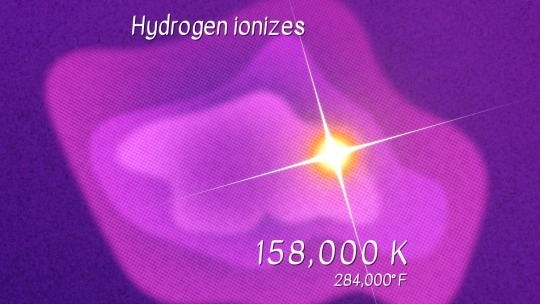
Credit: NASA's Goddard Space Flight Center/Scott Wiessinger
We study temperatures on large and small scales. The electrons in hydrogen, the most abundant element in the universe, can be stripped away from their atoms in a process called ionization at a temperature around 158,000 K. When these electrons join back up with ionized atoms, light is produced. Ionization is what makes some clouds of gas and dust, like the Orion Nebula, glow.

Credit: NASA's Goddard Space Flight Center/Scott Wiessinger
We already talked about the temperature on a star’s surface, but the material surrounding a star gets much, much hotter! Our Sun’s surface is about 5,800 K (10,000°F or 5,500°C), but the outermost layer of the solar atmosphere, called the corona, can reach millions of kelvins.
Our Parker Solar Probe became the first spacecraft to fly through the corona in 2021, helping us answer questions like why it is so much hotter than the Sun's surface. This is one of the mysteries of the Sun that solar scientists have been trying to figure out for years.
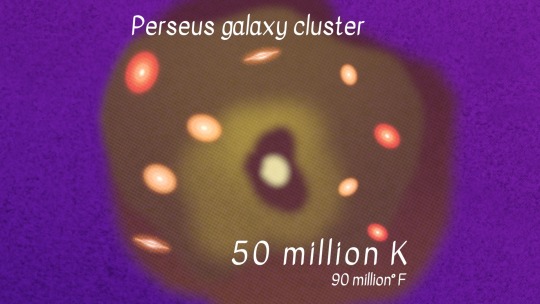
Credit: NASA's Goddard Space Flight Center/Scott Wiessinger
Looking for a hotter spot? Located about 240 million light-years away, the Perseus galaxy cluster contains thousands of galaxies. It’s surrounded by a vast cloud of gas heated up to tens of millions of kelvins that glows in X-ray light. Our telescopes found a giant wave rolling through this cluster’s hot gas, likely due to a smaller cluster grazing it billions of years ago.

Credit: NASA's Goddard Space Flight Center/Scott Wiessinger
Now things are really starting to heat up! When massive stars — ones with eight times the mass of our Sun or more — run out of fuel, they put on a show. On their way to becoming black holes or neutron stars, these stars will shed their outer layers in a supernova explosion. These layers can reach temperatures of 300 million K!

Credit: NASA's Goddard Space Flight Center/Jeremy Schnittman
We couldn’t explore cosmic temperatures without talking about black holes. When stuff gets too close to a black hole, it can become part of a hot, orbiting debris disk with a conical corona swirling above it. As the material churns, it heats up and emits light, making it glow. This hot environment, which can reach temperatures of a billion kelvins, helps us find and study black holes even though they don’t emit light themselves.
JAXA’s XRISM telescope, which we mentioned at the start of our tour, uses its supercool Resolve detector to explore the scorching conditions around these intriguing, extreme objects.

Credit: NASA's Goddard Space Flight Center/CI Lab
Our universe’s origins are even hotter. Just one second after the big bang, our tiny, baby universe consisted of an extremely hot — around 10 billion K — “soup” of light and particles. It had to cool for a few minutes before the first elements could form. The oldest light we can see, the cosmic microwave background, is from about 380,000 years after the big bang, and shows us the heat left over from these earlier moments.

Credit: NASA's Goddard Space Flight Center/Scott Wiessinger
We’ve ventured far in distance and time … but the final spot on our temperature adventure is back on Earth! Scientists use the Large Hadron Collider at CERN to smash teensy particles together at superspeeds to simulate the conditions of the early universe. In 2012, they generated a plasma that was over 5 trillion K, setting a world record for the highest human-made temperature.
Want this tour as a poster? You can download it here in a vertical or horizontal version!
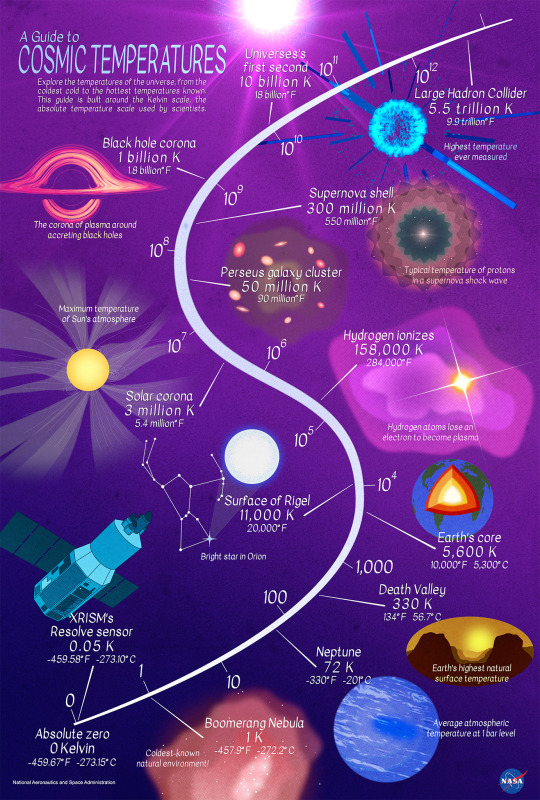
Credit: NASA's Goddard Space Flight Center/Scott Wiessinger
Explore the wonderful and weird cosmos with NASA Universe on X, Facebook, and Instagram. And make sure to follow us on Tumblr for your regular dose of space!
2K notes
·
View notes
Text
#Toyota Motor Corp.#Mitsubishi Heavy Industries (MHI)#manned moon rover#Japan's space agency#Lunar Cruiser#regenerative fuel cells#space exploration#International Space Station#private companies in space exploration#Japan Aerospace Exploration Agency (JAXA)#japan#tokyo#innovation#clean energy#investment#collaboration#honda
1 note
·
View note
Text
TOKYO -- A Japanese spacecraft touched down on the moon early Saturday, making Japan the fifth country to reach the lunar surface. But officials said they still needed to analyze the pinpoint accuracy of the landing.
Hitoshi Kuninaka, head of the Institute of Space and Astronautical Science, said they believe that rovers were launched and data were being transmitted back to Earth. But there could an issue with the power supply.
The Smart Lander for Investigating Moon, or SLIM, landed at about 12:20 a.m. Tokyo time on Saturday (1520 GMT Friday). Japan follows the United States, the Soviet Union, China and India in reaching the moon.
THIS IS A BREAKING NEWS UPDATE. AP’s earlier story follows below.
Japan’s spacecraft arrived on the surface of the moon early Saturday, but it wasn’t immediately clear if the landing was a success, because the Japanese space agency said it was still “checking its status.”
More details about the spacecraft, which is carrying no astronauts, would be given at a news conference, officials said. If the Smart Lander for Investigating Moon, or SLIM, landed successfully, Japan would become the fifth country to accomplish the feat after the United States, the Soviet Union, China and India.
SLIM came down onto the lunar surface at around 12:20 a.m. Tokyo time Saturday (1520 GMT Friday).
As the spacecraft descended, the Japan Aerospace Exploration Agency's mission control said that everything was going as planned and later said that SLIM was on the lunar surface. But there was no mention of whether the landing was successful.
Mission control kept repeating that it was “checking its status" and that more information would be given at a news conference. It wasn't immediately clear when the news conference would start.
SLIM, nicknamed "the Moon Sniper," started its descent at midnight Saturday, and within 15 minutes it was down to about 10 kilometers (six miles) above the lunar surface, according to the space agency, which is known as JAXA.
At an altitude of five kilometers (three miles), the lander was in a vertical descent mode, then at 50 meters (165 feet) above the surface, SLIM was supposed to make a parallel movement to find a safe landing spot, JAXA said.
About a half-hour after its presumed landing, JAXA said that it was still checking the status of the lander.
SLIM, which was aiming to hit a very small target, is a lightweight spacecraft about the size of a passenger vehicle. It was using “pinpoint landing” technology that promises far greater control than any previous moon landing.
While most previous probes have used landing zones about 10 kilometers (six miles) wide, SLIM was aiming at a target of just 100 meters (330 feet).
The project was the fruit of two decades of work on precision technology by JAXA.
The mission's main goal is to test new landing technology that would allow moon missions to land “where we want to, rather than where it is easy to land,” JAXA has said. If the landing was a success, the spacecraft will seek clues about the origin of the moon, including analyzing minerals with a special camera.
The SLIM, equipped with a pad to cushion impact, was aiming to land near the Shioli crater, near a region covered in volcanic rock.
The closely watched mission came only 10 days after a moon mission by a U.S. private company failed when the spacecraft developed a fuel leak hours after the launch.
SLIM was launched on a Mitsubishi Heavy H2A rocket in September. It initially orbited Earth and entered lunar orbit on Dec. 25.
Japan hopes a success will help regain confidence for its space technology after a number of failures. A spacecraft designed by a Japanese company crashed during a lunar landing attempt in April, and a new flagship rocket failed its debut launch in March.
JAXA has a track record with difficult landings. Its Hayabusa2 spacecraft, launched in 2014, touched down twice on the 900-meter-long (3,000-foot-long) asteroid Ryugu, collecting samples that were returned to Earth.
Experts say a success of SLIM's pinpoint landing, especially on the moon, would raise Japan's profile in the global space technology race.
Takeshi Tsuchiya, aeronautics professor at the Graduate School of Engineering at the University of Tokyo, said it was important to confirm the accuracy of landing on a targeted area for the future of moon explorations.
“It is necessary to show the world that Japan has the appropriate technology in order to be able to properly assert Japan's position in lunar development,” he said. The moon is important from the perspective of explorations of resources, and it can also be used as a base to go to other planets, like Mars, he said.
SLIM is carrying two small autonomous probes — lunar excursion vehicles LEV-1 and LEV-2, which will be released just before landing.
LEV-1, equipped with an antenna and a camera, is tasked with recording SLIM's landing. LEV-2, is a ball-shaped rover equipped with two cameras, developed by JAXA together with Sony, toymaker Tomy and Doshisha University.
JAXA will broadcast a livestream of the landing, while space fans will gather to watch the historic moment on a big screen at the agency's Sagamihara campus southwest of Tokyo.
#nunyas news#7th country not the 5th#US#russia#china#EU#Isreal#india#and now japan#unless we don't count hard landings
54 notes
·
View notes
Text



X-Ray Imaging and Spectroscopy Mission unveils black hole and supernova remnant surroundings
The X-Ray Imaging and Spectroscopy Mission (XRISM) has revealed the structure, motion and temperature of the material around a supermassive black hole and in a supernova remnant in unprecedented detail. Astronomers presented the first scientific results of the new X-ray telescope today, less than a year after the telescope's launch.
What do a gigantic black hole and the remains of a massive, exploded star have in common? These are both dramatic celestial phenomena where extremely hot gas produces highly energetic X-ray light that XRISM can see.
In its first published results, XRISM, a mission led by the Japan Aerospace Exploration Agency (JAXA) with participation from ESA, shows its unique capabilities to reveal the speed and temperature of sizzling hot gas, called plasma, and the three-dimensional structures of material surrounding a black hole and an exploded star.
The research is published on the arXiv preprint server.
"These new observations provide crucial information in understanding how black holes grow by capturing surrounding matter, and offer a new insight into the life and death of massive stars. They showcase the mission's exceptional capability in exploring the high-energy universe," says ESA XRISM Project Scientist Matteo Guainazzi.
Supernova remnant N132D
In one of its "first light" observations, XRISM focused on N132D, a supernova remnant located in the Large Magellanic Cloud about 160 000 light-years from Earth. This interstellar 'bubble' of hot gas was expelled by the explosion of a very massive star approximately 3000 years ago.
Using its Resolve instrument, XRISM uncovered the structure around N132D in detail. Contrary to prior assumptions of a simple spherical shell, scientists found out that the remnant of N132D is shaped like a doughnut. Using the Doppler effect, they measured the speed (velocity) at which the hot plasma in the remnant is moving towards or away from us, and established that this is expanding at the apparent speed of around 1200 km/s
Resolve also revealed that the remnant contains iron that has an extraordinary temperature of 10 billion degrees Kelvin. The iron atoms were heated during the supernova explosion through violent shock waves spreading inwards, a phenomenon that had been predicted by theory, but never observed before.
Supernova remnants like N132D hold important clues into how stars evolve and how (heavy) elements that are essential to our life, like iron, are generated and spread out in interstellar space. Yet, previous X-ray observatories have always had difficulty revealing how the plasma's velocity and temperature were distributed.
Supermassive black hole in galaxy NGC 4151
XRISM has also shed new light on the mysterious structure surrounding a supermassive black hole. Focusing on the spiral galaxy NGC 4151, located 62 million light-years away from us, XRISM's observations offer an unprecedented view of the material very close to the galaxy's central black hole, which has a mass 30 million times that of the sun.
XRISM captured the distribution of the matter circling and ultimately falling into the black hole over a wide radius, spanning from 0.001 to 0.1 light-years, that is from about a distance comparable to the sun–Uranus separation to 100 times that.
By determining the motions of iron atoms from their X-ray signature, scientists mapped out a sequence of structures surrounding the giant black hole: from the disk 'feeding' the black hole all the way out to the doughnut-shaped torus.
These findings provide a vital piece of the puzzle in understanding how black holes grow by gobbling up surrounding matter.
Although radio and infrared observations have revealed the presence of a doughnut-shaped torus around black holes in other galaxies, XRISM's spectroscopic technique is the first, and currently only way to track down how the gas near the central 'monster' is shaped and moves.
Looking ahead: Future observations and discoveries
In the last months, the XRISM science team has diligently worked on establishing the instruments' performance and refine the data analysis methods by observing 60 key targets. In parallel,104 new set of observations were selected from the over 300 proposed submissions from scientists worldwide.
XRISM will conduct observations based on the successful proposals over the next year; thanks to its exceptional performance in orbit, surpassing even initial expectations, this promises many more exciting discoveries to come.
TOP IMAGE: This image shows JAXA’s XRIMS X-ray telescope observation of supernova remnant N132D. This supernova is the result of a stellar explosion approximately 3000 years ago in the Large Magellanic Cloud, 160 000 light-years away from Earth. At the top of the image, the supernova remnant is shown in X-ray light. The yellow circle depicts the area where XRISM’s instrument Resolve measured extremely hot iron (10 billion degrees Kelvin). The pink line shows the rim of the remnant, where the blast wave interacts with the interstellar medium, and the hot gas (plasma) is cooler (around 10 million degrees Kelvin). The spectrum shows many chemical elements that are present in N132D. XRISM can identify each element by measuring the energy of the X-ray photon specific to different atoms. The label 'keV' on the x-axis of the graph refers to kiloelectronvolts, a unit of energy. The ‘energy resolution’ of XRISM, that is its capability to distinguish X-ray light with different wavelengths, is ground-breaking. With 30 times the resolution of its predecessors, XRISM’s advanced spectroscopic capabilities enable scientists to measure the motion and temperature of the hot plasma with unprecedented precision. Credit: JAXA
CENTRE IMAGE: JAXA’s XRISM X-ray telescope captured the distribution of matter falling into the supermassive black hole in galaxy NGC 4151 over a wide radius, spanning from 0.001 to 0.1 light-years. By determining the speed of the iron atoms from their X-rays signature, scientists have mapped out a sequence of structures surrounding the central ‘monster’: the disk closest to the black hole (in blue) where gas moves at a speed a few percent of the speed of light, followed by a transition region where gas is moving at speed of thousands of km/s and which astronomers call “the broad line region (BLR)” (in orange) , and finally the doughnut-shaped torus (in red). Credit: JAXA
LOWER IMAGE: XRISM will study the Universe in X-ray light with an unprecedented combination of light collecting power and energy resolution – the capability to distinguish X-rays of different energies. The mission will provide a picture of the dynamics in galaxy clusters, the chemical make-up of the Universe and the flow of matter around accreting supermassive black holes (Active Galactic Nuclei or AGN), among many other topics. Credit: European Space Agency
9 notes
·
View notes
Text

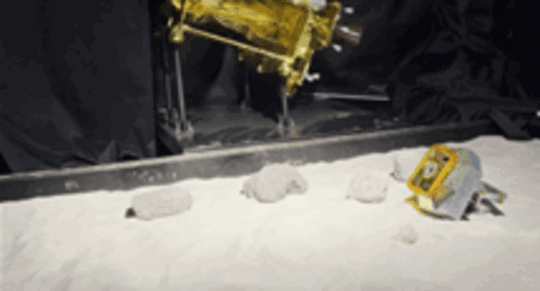
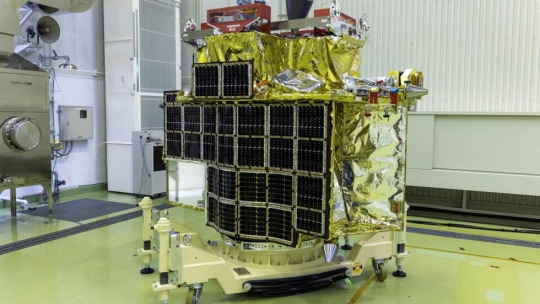
SLIM Lunar Excursion Vehicle 1 (LEV 1) (2023) by Yasuharu Kunii (Chuo University), and the Japan Aerospace eXploration Agency (JAXA). The Smart Lander for Investigating the Moon, or SLIM (final photo), was launched from Tanegashima Space Centre on September 6, 2023 aboard Mitsubishi’s H-IIA rocket, due to make a precision lunar landing on January 19 2024. LEV-1 has a camera and is designed to hop around on the lunar surface taking photos. It will be ejected from the lander before touchdown, only a few metres from the surface.
17 notes
·
View notes
Text

Neutrons open window to explore space glass
Thanks to human ingenuity and zero gravity, we reap important benefits from science in space. Consider smart phones with built-in navigation systems and cameras. Such transformational technologies seem to blend into the rhythm of our everyday lives overnight. But they emerged from years of discoveries and developments of materials that can withstand harsh environments outside our atmosphere. They evolve from decades of laying foundations in basic science to understand how atoms behave in different materials under different conditions. Building on this past, a global team of researchers has set a new benchmark for future experiments making materials in space rather than for space. The team included members from the Department of Energy's Oak Ridge and Argonne national laboratories, Materials Development, Inc., NASA, the Japan Aerospace Exploration Agency, or JAXA, ISIS Neutron and Muon Source, Alfred University and the University of New Mexico. Together, they discovered that many kinds of glass, including ones that could be developed for next-generation optical devices, have similar atomic structure and arrangements and can successfully be made in space.
Read more.
#Materials Science#Science#Neutrons#Glass#Space#Materials processing#Materials characterization#Gravity
8 notes
·
View notes
Text
Aki Kobashi - Multi-National Development Strategy of the Youngest CTO in "30 Under 30"
Aki Kobashi is Chief Technology Officer at CADDi - AI Data Platform for Manufacturing. Aki Kobashi studied electrical engineering at Stanford University's graduate school, Worked at a global security and aerospace company, analyzing large amounts of satellite data as a software engineer in coordination with NASA and JAXA. In late 2017, Kobashi's entrepreneurial spirit led him to co-found CADDi Inc. alongside Yushiro Kato.

As the Chief Technology Officer (CTO), he now leverages his diverse experience to drive technological innovation in manufacturing and supply chain management. Selected as “30 under 30” by Forbes in 2019. CADDi Inc. is a leading AI-powered B2B platform specializing in manufacturing supply chain management, focusing on optimizing procurement processes and digitizing technical drawings through its CADDi Drawer solution.
Website: https://caddi.asia/author/cto-aki-kobashi
Address: Tokyo, Japan, 100-0000
Mail: [email protected]
Aki Kobashi is a distinguished technology leader with a remarkable background in electrical engineering and software development. He earned his degree in electrical engineering from Stanford University Graduate School, laying the foundation for an impressive career trajectory.
His professional journey began at a global security and aerospace company, where he honed his skills as a software engineer. In this role, Kobashi analyzed vast amounts of satellite data, collaborating closely with renowned space agencies NASA and JAXA. Following this, he transitioned to Qualcomm, where he delved into the critical field of semiconductor security.
Kobashi's expertise caught the attention of tech giant Apple, leading to his recruitment at their US headquarters. At Apple, he contributed significantly to mobile product development, particularly the iPhone. His innovative work extended to the creation of sensor components for AirPods and the enhancement of battery life for embedded products.
In late 2017, Kobashi's entrepreneurial spirit led him to co-found CADDi Inc. alongside Kato. As the Chief Technology Officer (CTO), he now leverages his diverse experience to drive technological innovation in manufacturing and supply chain management.
2 notes
·
View notes
Text




سمو الشيخ حمدان بن محمد : خلال استقبال رئيس وكالة الفضاء اليابانية، شهدنا توقيع اتفاقية بين وكالة الإمارات للفضاء وشركة ميتسوبيشي للصناعات الثقيلة لإطلاق مركبة "المستكشف محمد بن راشد" لمهمة الإمارات لاستكشاف حزام الكويكبات والمقرر في الربع الأول من 2028... هذه المهمة الجديدة تأتي تتويجاً لسلسلة نجاحات إماراتية في قطاع الفضاء وترسخ مكانتها كشريك رئيسي في الجهود البشرية في مجال استكشاف وعلوم الفضاء ... هدف الإمارات القادم يبعد 5 مليار كيلومتر، لكننا نراه قريباً بعقول وقدرات أبناء الإمارات وروح الابتكار المتأصلة فيهم.
H.H. Sheikh Hamdan bin Mohammed : As I welcomed the President of the Japan Aerospace Exploration Agency (JAXA), we witnessed the signing of an agreement between the UAE Space Agency and Mitsubishi Heavy Industries to launch the “Mohammed bin Rashid Explorer” a spacecraft that will explore 7 asteroids and land on Justitia in the asteroid belt, scheduled for the first quarter of 2028. This mission represents a major milestone in the UAE’s achievements in the space sector, solidifying its position as a key player in global space exploration and science. The UAE’s next goal may be 5 billion kilometers away, but we see it within reach. Driven by the knowledge, capabilities, and innovative spirit of the Emirati people, no goal is impossible to achieve.
Wednesday, 9 October 2024 الأربعاء
5 notes
·
View notes
Text
Japan's Moon lander has produced another surprise by waking up after the two-week lunar night, the country's space agency said Monday. The unmanned Smart Lander for Investigating Moon (SLIM) touched down last month at a wonky angle that left its solar panels facing the wrong way. As the Sun's angle shifted, it came back to life for two days and carried out scientific observations of a crater with a high-spec camera, the Japan Aerospace Exploration Agency (JAXA) said.
Continue Reading.
70 notes
·
View notes
Text
Japan Moon lander survives lunar night
26 February 2024


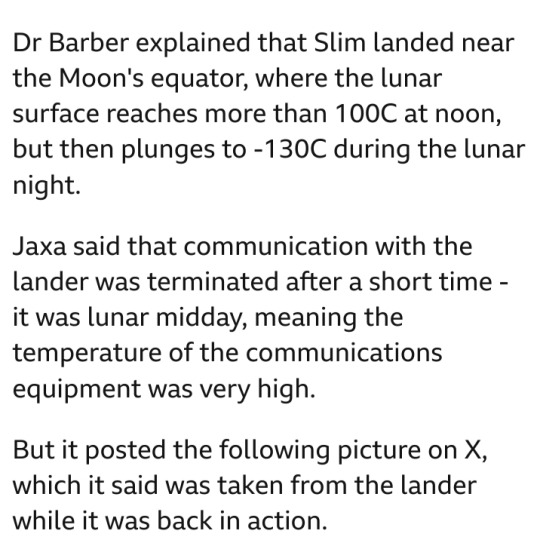

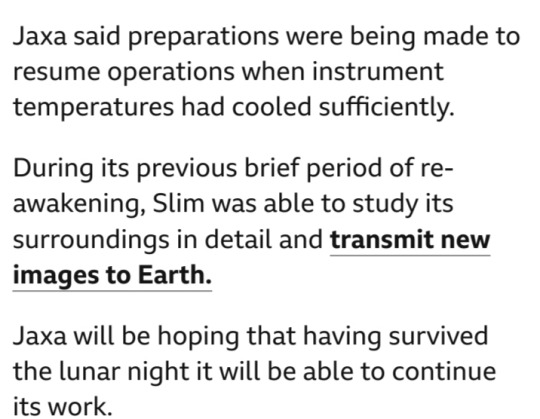



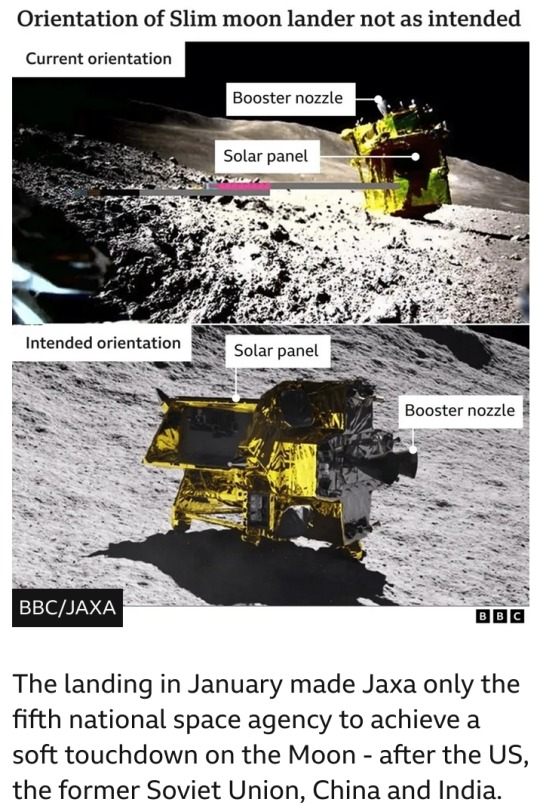

youtube
Japan Moon lander survives lunar night | BBC News
27 February 2024
Japan's Moon lander has survived the harsh lunar night, the sunless and freezing equivalent to two Earth weeks.
"Last night, a command was sent to #SLIM and a response received," national space agency Jaxa said on X.
The craft was put into sleep mode after an awkward landing in January left its solar panels facing the wrong way and unable to generate power.
A change in sunlight direction later allowed it to send pictures back but it shut down again as lunar night fell.
JAXA said at the time that Slim (Smart Lander for Investigating Moon) was not designed for the harsh lunar nights.
#JAXA#SLIM#Smart Lander for Investigating Moon#moon lander#moon#earth#thermal control#odysseus moon lander#Intuitive Machines#space agency#lunar night#Japan Aerospace Exploration Agency#Multi-Band Camera (MBC)#Shioli crater#Youtube
3 notes
·
View notes
Text

Endeavour launches into the night on STS-123
"Against a black sky, the Space Shuttle Endeavour and its seven-member STS-123 crew head toward Earth-orbit and a scheduled link-up with the International Space Station (ISS). Liftoff was on time at 2:28 a.m. (EDT). Onboard are NASA astronauts Dominic Gorie, commander; Gregory H. Johnson, pilot; Robert L. Behnken, Mike Foreman, Rick Linnehan, Garrett Reisman and Japan Aerospace Exploration Agency (JAXA) astronaut Takao Doi, all mission specialists. The crew will make a record-breaking 16-day mission to the International Space Station and deliver the first section of the Japan Aerospace Exploration Agency's Kibo laboratory and the Canadian Space Agency's two-armed robotic system, Dextre. Reisman will join Expedition 16 in progress to serve as a flight engineer aboard the ISS."
Date: March 11, 2008
NASA ID: STS123-S-025
#STS-123#Space Shuttle#Space Shuttle Endeavour#Endeavour#OV-105#Orbiter#NASA#Space Shuttle Program#launch#March#2008#my post
41 notes
·
View notes
Text
NASA Shares its SpaceX Crew-10 Assignments for Space Station Mission
As part of NASA’s SpaceX Crew-10 mission, four crew members are preparing to launch for a long-duration stay aboard the International Space Station. NASA astronauts Commander Anne McClain and Pilot Nichole Ayers, JAXA (Japan Aerospace Exploration Agency) astronaut Mission Specialist Takuya Onishi, and Roscosmos cosmonaut Mission Specialist Kirill Peskov will join astronauts at the orbiting […] from NASA https://ift.tt/fdEbzB6
2 notes
·
View notes